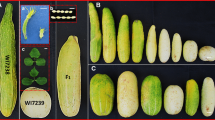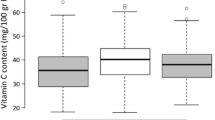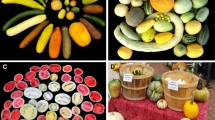Abstract
Quantitative trait locus (QTL) mapping for fruit weight and shape in pepper (Capsicum spp.) was performed using C. chinense and C. frutescens introgression lines of chromosomes 2 and 4. In chromosome 2, a single major fruit-weight QTL, fw2.1, was detected in both populations that explained 62% of the trait variation. This QTL, as well as a fruit-shape QTL, fs2.1, which had a more minor effect, were localized to the tomato fruit-shape gene ovate. The cloned tomato fruit-weight QTL, fw2.2, did not play a major role in controlling fruit size variations in pepper. In chromosome 4, two fruit-weight QTLs, fw4.1 and fw4.2, were detected in the same genomic regions in both mapping populations. In addition, a single fruit-shape QTL was detected in each of the mapping populations that co-localized with one of the fruit-weight QTLs, suggesting pleiotropy or close linkage of the genes controlling size and shape. fw2.1 and fw4.2 represent major fruit-weight QTLs that are conserved in the three Capsicum species analyzed to date for fruit-size variations. Co-localization of the pepper QTLs with QTLs identified for similar traits in tomato suggests that the pepper and tomato QTLs are orthologous. Compared to fruit-shape QTLs, fruit-weight QTLs were more often conserved between pepper and tomato. This implies that different modes of selection were employed for these traits during domestication of the two Solanaceae species.






Similar content being viewed by others
References
Ben Chaim A (2002) Analysis of quantitative traits in pepper (Capsicum spp.) using molecular markers and comparative mapping with tomato. A PhD thesis submitted to the Hebrew University of Jerusalem
Ben Chaim A, Paran I, Grube R, Jahn M, van Wijk R, Peleman J (2001) QTL mapping of fruit related traits in pepper (Capsicum annuum). Theor Appl Genet 102:1016–1028
Ben Chaim A, Borovsky E, Rao GU, Tanyolac B, Paran I (2003a) fs3.1: a major fruit shape QTL conserved in Capsicum. Genome 46:1–9
Ben Chaim A, Borovsky Y, De Jong W, Paran I (2003b) Linkage of the A locus for the presence of anthocyanin and fs10.1, a major fruit-shape QTL in pepper. Theor Appl Genet 106:889–894
Cong B, Liu J, Tanksley SD (2002) Natural alleles at a tomato fruit size quantitative trait locus differ by heterochronic regulatory mutations. Proc Natl Acad Sci USA 99:13606–13611
Doganlar S, Frary A, Daunay MC, Lester RN, Tanksley SD (2002a) A comparative genetic linkage map of eggplant (Solanum melongena) and its implications for genome evolution in the Solanaceae. Genetics 161:1697–1711
Doganlar S, Frary A, Daunay MC, Lester RN, Tanksley SD (2002b) Conservation of gene function in the Solanaceae as revealed by comparative mapping of domestication traits in eggplant. Genetics 161:1713–1726
Eshed Y, Zamir D (1995) An introgression line population of Lycopersicon pennellii in the cultivated tomato enables the identification and fine mapping of yield-associated QTL. Genetics 141:1147–1162
Frary A, Nesbitt TC, Frary A, Grandillo S, van der Knapp E, Cong B, Liu J, Meller J, Elber R, Alpert KB, Tanksley SD (2000) fw2.2: a quantitative trait locus key to the evolution of tomato fruit size. Science 289:85–88
Fridman E, Liu YS, Carmel-Goren L, Gur A, Shoresh M, Pleban T, Eshed Y, Zamir D (2002) Two tightly linked QTLs modify tomato sugar content via different physiological pathways. Mol Genet Genomics 266:821–826
Grandillo S, Ku HM, Tanksley SD (1999) Identifying the loci responsible for natural variation in fruit size and shape in tomato. Theor Appl Genet 99:978–987
Grube RC, Radwanski ER, Jahn MM (2000) Comparative genetics of disease resistance within the Solanaceae. Genetics 155:873–887
Lander ES, Green P, Abrahamson J, Barlow A, Daly MJ, Lincoln SE, Newburg L (1987) mapmaker: an interactive computer package for constructing primary genetic linkage maps of experimental and natural populations. Genomics 1:174–181
Lecomte L, Saliba-Colombani V, Gautier A, Gomez-Jimenez MC, Duffé P, Buret M, Causse M (2004) Fine mapping of QTLs of chromosome 2 affecting the fruit architecture and composition of tomato. Mol Breed 13:1–14
Lippman Z, Tanksley SD (2001) Dissecting the genetic pathway to extreme fruit size in tomato using a cross between the small-fruited wild species Lycopersicon pimpinellifolium and L. esculentum, var. Giant Heirloom. Genetics 158:413–422
Liu J, Van Eck J, Cong B, Tanksley SD (2002) A new class of regulatory genes underlying the cause of pear-shaped tomato fruit. Proc Natl Acad Sci USA 99:13302–13306
Livingstone KD, Lackney VK, Blauth J, Wijk VR, Jahn MK (1999) Genome mapping in Capsicum and the evolution of genome structure in the Solanaceae. Genetics 152:1183–1202
Monforte A, Friedman E, Zamir D, Tanksley SD (2001) Comparison of a set of alleleic QTL-NILs for chromosome 4 of tomato: deductions about natural variation and implications for germplasm collection. Theor Appl Genet 102:572–590
Nelson CJ (1997) qgene: software for marker-based genomic analysis and breeding. Mol Breed 3:229–235
Paterson AH, Bowers JE, Burow MD, Draye X, Elsik CG, Jiang CX, Katsar CS, Lan TH, Lin YR, Ming R, Wright RJ (2000) Comparative genomics of plant chromosomes. Plant Cell 12:1523–1539
Rao GU, Ben Chaim A, Borovsky E, Paran I (2003) Mapping of yield related QTLs in pepper in an inter-specific cross of Capsicum annuum and C. frutescens. Theor Appl Genet 106:1457–1466
SAS Institute (2000) JMP Users Guide: version 4.0. SAS Institute, Cary, N.C.
Tanksley SD (2004) The genetic, developmental, and molecular bases of fruit size and shape variation in tomato. Plant Cell 16:S181–S189
Tanksley SD, Ganal MW, Prince JP, deVicente MC, Bonierbale MW, Broun P, Fulton TM, Giovanonni JJ, Grandillo S, Martin GB, Messeguer R, Miller JC, Miller L, Paterson AH, Pineda O, Roder MS, Wing RA, Wu W, Young ND (1992) High density molecular linkage maps of the tomato and potato genomes. Genetics 132:1141–1160
Thorup TA, Tanyolac B, Livingstone KD, Popovsky S, Paran I, Jahn M (2000) Candidate gene analysis of organ pigmentation loci in the Solanaceae. Proc Natl Acad Sci USA 97:11192–11197
Van Ooijen JW, Boer MP, Jansen RC, Maliepaard C (2002) mapqtl 4.0, software for the calculation of QTL positions on genetic maps. Plant research international, Wageningen
Wilson LM, Whitt SR, Ibanez AM, Rocheford TR, Goodman MM, Buckler IV ES (2004) Dissection of maize kernel composition and starch production by candidate gene association. Plant Cell 16:2719–2733
Yates HE, Frary A, Doganla S, Frampton A, Eannetta NT, Uhlig J, Tanksley SD (2004) Comparative fine mapping of fruit quality QTLs on chromosome 4 introgressions derived from two wild tomato species. Euphytica 135:283–296
Acknowledgements
This research was supported by The Israel Science Foundation (Grant No. 643/00) and by The United States-Israel Binational Agricultural Research and Development Fund Grant No. IS-3225-01C.
Author information
Authors and Affiliations
Corresponding author
Additional information
Communicated by R. Hagemann
S. Zygier and A. Ben Chaim contributed equally to this work.
Rights and permissions
About this article
Cite this article
Zygier, S., Chaim, A.B., Efrati, A. et al. QTLs mapping for fruit size and shape in chromosomes 2 and 4 in pepper and a comparison of the pepper QTL map with that of tomato. Theor Appl Genet 111, 437–445 (2005). https://doi.org/10.1007/s00122-005-2015-7
Received:
Accepted:
Published:
Issue Date:
DOI: https://doi.org/10.1007/s00122-005-2015-7




